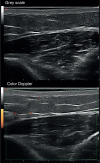Assessment of Sclerodermoid Chronic Graft-versus-host Disease with Colour Doppler Ultrasound
- PMID: 33475145
- PMCID: PMC9366684
- DOI: 10.2340/00015555-3747
Assessment of Sclerodermoid Chronic Graft-versus-host Disease with Colour Doppler Ultrasound
Abstract
Sclerodermoid chronic graft-versus-host disease (scGVHD) is a severe complication of allogeneic haema-- topoietic stem cell transplantation. The aim of this study was to investigate the usefulness of high-frequency ultrasound of the skin in assessing the inflammatory patterns and prognosis of patients with scGVHD. A prospective study was carried out with patients who developed scGVHD in the period June 2016 to April 2018. Clinical and ultrasound examinations were performed on the first visit and at 6-month follow-up. A total of 24 patients were included in the study. A 6-month follow-up high-frequency ultrasound of the skin was performed on 20 of the 24 patients. Abnormal B-mode findings in high-frequency ultrasound of the skin consisted of hypoechogenic dermis, hypoechogenicity of septa and hyperechogenicity of lobules in hypodermis. No differences were observed in these basal parameters between treatment progressive/non-responding and inactive/responding scGVHD groups of patients. Basal Doppler showing increased vascular flow with a systolic peak ≥10 cm/s and a vascular resistance index ≥ 0.70 was observed only in those patients who developed progressive/non-responding scGVHD (62.5% vs 0% p = 0.006). In conclusion, Doppler ultrasound is a useful tool to assess the inflammatory activity and outcome of scGVHD. These findings could enhance patient management and help to guide treatment decisions.
Keywords: Doppler ultrasound; allogeneic haematopoietic stem cell transplantation; diagnosis; inflammation; sclerodermoid; graft-versus-host disease.
Conflict of interest statement
Figures



Similar articles
-
Pressure-induced isomorphic sclerodermoid graft-versus-host disease from brassiere underwire and tight-fitting watch.Dermatol Online J. 2015 Nov 18;21(11):13030/qt74d3w4cn. Dermatol Online J. 2015. PMID: 26632934
-
Chronic cutaneous sclerodermoid graft-versus-host disease: evaluation by 20-MHz sonography.J Eur Acad Dermatol Venereol. 2003 Jul;17(4):402-7. doi: 10.1046/j.1468-3083.2003.00516.x. J Eur Acad Dermatol Venereol. 2003. PMID: 12834449
-
[Sclerodermatous chronic graft-versus-host disease after hematopoietic stem cell transplantation: incidence, clinical characteristics and risk factors].Nan Fang Yi Ke Da Xue Xue Bao. 2016 Jun;36(6):807-13. Nan Fang Yi Ke Da Xue Xue Bao. 2016. PMID: 27320883 Chinese.
-
Neurological manifestations of chronic graft-versus-host disease after allogeneic haematopoietic stem cell transplantation: report from the Consensus Conference on Clinical Practice in chronic graft-versus-host disease.Brain. 2010 Oct;133(10):2852-65. doi: 10.1093/brain/awq245. Epub 2010 Sep 15. Brain. 2010. PMID: 20846944 Review.
-
Cutaneous graft-versus-host disease after hematopoietic stem cell transplant - a review.An Bras Dermatol. 2016 May-Jun;91(3):336-43. doi: 10.1590/abd1806-4841.20164180. An Bras Dermatol. 2016. PMID: 27438202 Free PMC article. Review.
Cited by
-
Advanced Doppler Ultrasound Insights: A Multicenter Prospective Study on Healthy Skin.Diagnostics (Basel). 2025 Feb 26;15(5):569. doi: 10.3390/diagnostics15050569. Diagnostics (Basel). 2025. PMID: 40075816 Free PMC article.
-
Pediatric Transplant and Cellular Therapy Consortium RESILIENT Conference on Pediatric Chronic Graft-Versus-Host Disease Survivorship After Hematopoietic Cell Transplantation: Part I. Phases of Chronic GVHD, Supportive Care, and Systemic Therapy Discontinuation.Transplant Cell Ther. 2025 Feb;31(2):69.e1-69.e18. doi: 10.1016/j.jtct.2024.12.011. Epub 2024 Dec 17. Transplant Cell Ther. 2025. PMID: 39701289
-
High-Frequency Ultrasound to Assess Activity in Connective Tissue Panniculitis.J Clin Med. 2021 Sep 29;10(19):4516. doi: 10.3390/jcm10194516. J Clin Med. 2021. PMID: 34640532 Free PMC article.
References
-
- Lee SJ, Flowers MED. Recognizing and managing chronic graft-versus-host disease. Hematol Am Soc Hematol Educ Program 2008; 1: 134–141. - PubMed
-
- Cowen EW. Graft-vs-host disease. JAMA Dermatol 2016; 152: 356. - PubMed
-
- Jagasia MH, Greinix HT, Arora M, Williams, K, Wolff D, Cowen E, et al. . National Institutes of Health Consensus Development Project on criteria for clinical trials in chronic graft-versus-host disease: I. The 2014 Diagnosis and Staging Working Group report. Biol Blood Marrow Transplant J Am Soc Blood Marrow Transplant 2015; 21: 389–401.e1. - PMC - PubMed
-
- Wortsman X. Ultrasound in dermatology: why, how, and when? Semin Ultrasound CT MR 2013; 34: 177–195. - PubMed
MeSH terms
LinkOut - more resources
Full Text Sources
Other Literature Sources
Miscellaneous

